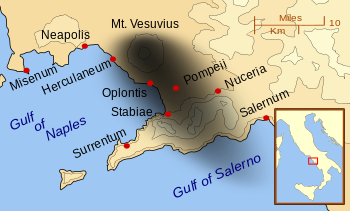Stabiae
 Wall painting from Stabiae, 1st century AD | |
| Location | Castellammare di Stabia, Province of Naples, Campania, Italy |
|---|---|
| Region | Southern Italy |
| Coordinates | 40°42′11″N 14°29′56″E / 40.70306°N 14.49889°E |
| Type | Settlement |
| Site notes | |
| Management | Soprintendenza Speciale per i Beni Archeologici di Pompei, Ercolano e Stabia |
| Website | Sito Archeologico di Stabiae (in Italian and English) |

Stabiae was a Ancient Roman settlement, about 4.5 kilometres (2.8 mi) southwest of Pompeii. Like Pompeii, this seaside resort was largely buried by tephra ash in the 79 AD eruption of Mount Vesuvius, in this case at a smaller depth of up to five metres.[1] It is only 16 km (9.9 mi) from Mount Vesuvius.
Stabiae is most famous for the Roman villas found near the ancient. They are some of the most stunning architectural and artistic remains from any Roman villas.[2] They are the largest concentration of well-preserved, enormous, elite seaside villas found from the entire Roman world. The villas were on a 50 m high headland overlooking the Gulf of Naples.[3][4] Although it was discovered before Pompeii in 1749, unlike Pompeii and Herculaneum, Stabiae was reburied by 1782 and so failed to establish itself as a destination for travellers on the Grand Tour.
Many of the objects and frescoes taken from these villas are now in the National Archaeological Museum of Naples.
There had already been a settlement there, before the Romans. The port of Stabiae already existed in the 6th century BC, but was much smaller than that of Pompeii. In 89 BC, Sulla descroyed much of Stabiae.Pliny the Elder repüorted that the city was rebuilt soon afterwards. According to him, it was a popular destination for wealthy Romans.
References
[change | change source]- ↑ Giovanna Bonifacio; Anna Maria Sodo, Gina Carla Ascione, In Stabiano - Cultura e archeologia da Stabiae , Castellammare di Stabia, Longobardi Editore, 2006. ISBN 88-8090-126-5 p. 117-118
- ↑ Stabiae: Master Plan 2006, the Archaeological Superintendancy of Pompeii, School of Architecture of the University of Maryland, The Committee of Stabiae Reborn
- ↑ San Diego Museum of Art exhibition on Stabiae Archived 10 February 2006 at the Wayback Machine
- ↑ "Restoring Stabiae website". Archived from the original on 2022-01-27. Retrieved 2023-05-07.
